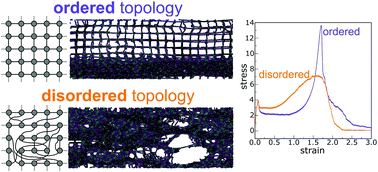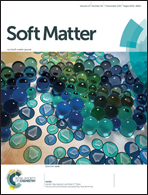Topological structure and mechanics of glassy polymer networks
Abstract
The influence of chain-level network architecture (i.e., topology) on mechanics was explored for unentangled polymer networks using a blend of coarse-grained molecular simulations and graph-theoretic concepts. A simple extension of the Watts–Strogatz model is proposed to control the graph properties of the network such that the corresponding physical properties can be studied with simulations. The architecture of polymer networks assembled with a dynamic curing approach were compared with the extended Watts–Strogatz model, and found to agree surprisingly well. The final cured structures of the dynamically-assembled networks were nearly an intermediate between lattice and random connections due to restrictions imposed by the finite length of the chains. Further, the uni-axial stress response, character of the bond breaking, and non-affine displacements of fully-cured glassy networks were analyzed as a function of the degree of disorder in the network architecture. It is shown that the architecture strongly affects the network stability, flow stress, onset of bond breaking, and ultimate stress while leaving the modulus and yield point nearly unchanged. The results show that internal restrictions imposed by the network architecture alter the chain-level response through changes to the crosslink dynamics in the flow regime and through the degree of coordinated chain failure at the ultimate stress. The properties considered here are shown to be sensitive to even incremental changes to the architecture and, therefore, the overall network architecture, beyond simple defects, is predicted to be a meaningful physical parameter in the mechanics of glassy polymer networks.



 Please wait while we load your content...
Please wait while we load your content...